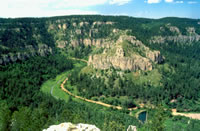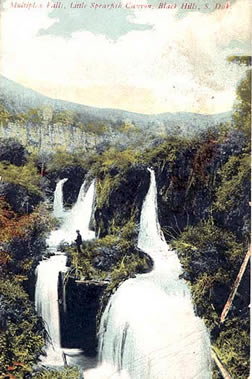Agrarian Culture - Gold Rush
An attempt was made to keep the prospectors out of the Hills according to the Fort Laramie Treaty of 1868, but by 1875, and the confirmation of gold in the Hills by the Custer Expedition of 1874, it became a futile exercise as people poured into the Hills. A clash of the nomadic and agrarian cultures ensued. The outcome is a story retold throughout the world in the ages of man as the dominant Agrarian Culture prevailed.
The "gold rush" of 1876 brought hundreds of miners through the Canyon west-to-east in route to the lure of gold surrounding an area known later as Lead and Deadwood. Many say the historic name Savoy was given by one of those miners who while viewing the Canyon for the first time reminded him of back home in the richly forested and mineralized Savoy area of the southern Italian Alps.
The Canyon was impassable north-to-south. However, it was possible to 'slowly' ride horseback down the Canyon to where Little Spearfish Creek met Spearfish River (as it was then known). The convergence of these two water bodies created one of the most spectacular water falls in the region. The thunderous roar of the falls and the huge clouds of spray rising one hundred feet into the tree line easily marked the natural wonder. But from this point to Maurice seven miles away, it was impossible to travel through the rugged terrain with dense thickets and undergrowth, even by horseback. From the lower end of the canyon near Spearfish, travelers could reach Maurice where Homestake had built a steam power plant.
Tie & Timber Sawmill
In 1891, Mr. George Belshaw built a one room cabin which was used as an office by Mr. McLaughlin and Mr. Lepke who in 1892 established a sawmill across the road where the new Spearfish Canyon Lodge now resides. This cabin later became the original first room of the Latchstring Inn.
The mill, owned by the Tie and Timber Company, employed many local ranchers and logging men for the sawing and hewing of the heavy timbers to be used in the building of the railroad which was at that time laboriously crossing the Hills from Deadwood. In the succeeding decade, much of the surrounding forest was cut to accommodate the great expansion demands made by the railroad and by the ranchers, homesteaders, miners, and prospectors for their expanding operations in the northern Hills.
Chicago Burlington Quincy Railroad
In 1893, Spearfish Canyon, for the first time, was opened by the railroad. This engineering marvel consisted of three hundred and seventy five curves of sheer up and down hill climbing. In all, the thirty two mile "Spearfish Spur" left Deadwood, rose 1,886 feet in six miles to Trojan ( then known as Portland), then down 2,778 in twenty-five miles spanning thirty-three bridges to Spearfish. The ties were bedded in rock the whole way and the freight cars had to be chained to the siding to keep them from rolling to the bottom at Spearfish. The Grand Island & Wyoming Line built the spur but then sold it to the Chicago, Burlington & Quincy a short time later for more than $2-million. In an early brochure citing the breathtaking engineering accomplishments, the Burlington called the Canyon trip, "for sheer artistry of description, it need bow to no other."
The railroad was very accommodating in those days. The schedule was one train a day, and the crew was most happy to let the fisherman, sightseers, picnickers, berry pickers, and the like off at any place they chose and pick them up again on the return trip.
One of the most scenic and thrilling spots on the Spearfish Canyon train ride was Spearfish Falls. The crew would stop the train on the vibrating trestle spanning the falls offering a thrilling sight of the waters thundering impact below.
Latchstring Inn
With much of the local timber resources depleted, and the necessary relocation of the Tie and Timber Company in 1906, Mr. Glen Inglis of Deadwood bought the office as a fishing and hunting cabin. Soon after, he married Dorothy Smith, and they established Glendoris (Glen and Doris) Lodge, the first resort in Spearfish Canyon. Six deserted miners and logger cabins were converted to sleeping accommodations. During this time, many cowboys, ranchers, miners, and varied guests would ride to the Glendoris, spent the night, and catch the train to Spearfish, Lead or Deadwood. The increased business necessitated the building of six more rooms known as "Hard Boiled Alley." During this period, Teddy Roosevelt and Seth Bullock, sheriff of Lawrence County, often visited to hunt, fish, and enjoy the beauty of Spearfish Canyon.
With the success of Homestake Mining Company in Lead and the expansion of its operation and employment, in 1916, the company constructed a six mile pipeline through the Canyon which diverted much of the waters of the Big and Little Spearfish Creeks to the hydroelectric plant at Maurice. The water was then released for a short distance and then funneled into a large tunnel four and one-half miles long to a Homestake electric plant in Spearfish. The water was then released and ran through the city of Spearfish before being used as irrigation by ranchers downstream.
In 1919 two young ladies, Martha Railback, a graduate of DePauw University from Indianapolis, Indiana, and Maude Watts of Belleville, Ontario while taking a trip through the West stopped at the mountain inn. They were so taken by the Glendoris and its surroundings that they decided to purchase it. As all the doors were opened by latchstrings, they renamed the resort, The Latchstring Inn. By then, Savoy consisted of the mountain Inn, six miner's cabins, a general store, a post office, and railroad station.
A familiar visitor at Latchstring Inn was Potato Creek Johnny, famous for finding the largest gold nugget in the Hills.
 By the early thirties, the automobile was becoming the accepted means of travel, trucks were being developed for hauling, and roadways were beginning to span the Black Hills. In 1933, a heavy flood washed away two miles of track and trestle of the railroad. By then the railroad had lost their interest in resuming the line and it was abandoned and the track removed in 1934. During the period 1933 to 1950, a rough, chuck-holed and tiring mud road was the only means available for the weary traveler to reach the Latchstring. By the early thirties, the automobile was becoming the accepted means of travel, trucks were being developed for hauling, and roadways were beginning to span the Black Hills. In 1933, a heavy flood washed away two miles of track and trestle of the railroad. By then the railroad had lost their interest in resuming the line and it was abandoned and the track removed in 1934. During the period 1933 to 1950, a rough, chuck-holed and tiring mud road was the only means available for the weary traveler to reach the Latchstring.
By 1950, a new roadway, once the paths made by wagon wheels, railroad spurs, and the automobile tires, had been built and blacktopped and the number of vacationers increased and business flourished. More services were added to the Inn including a coffee shop (1956), chapel, (1957), and four new cabins (1960).
Over the years, decay had taken its toll and preservation architects could not preserve the historic facility. In 1989 the Latchstring Inn was replaced with a modern log building called the Latchstring. It houses a restaurant, gift shop, and lounge. In 1995 the historical tradition of public sleeping accommodation was preserved by the construction of a new and beautiful 54-room lodge on the site of the old McLaughlin Sawmill.
The history of Latchstring and the progress of civilization in Spearfish Canyon overcame many natural barriers with engineering marvels. Sawmills had reaped their harvest of timber and rotting stumps remain under the new and revitalized forest canopy. The railroad came, prospered, outlived its usefulness, and then was abandoned leaving behind occasional charming contours of rail beds and trestles. Disappointed miners left gaping prospector holes and mounds of spent ore on the hillsides which over the years have been naturally reclaimed and are part of the inspiring landscape. Some of the rapid waters of Spearfish River were harnessed and put to work generating electrical power for the largest underground mine in the nation, Homestake Mining Company. But that too had an end as Homestake began closing procedures in 2002. Despite its seemingly pristine appearance, the hardy Canyon has been the scene of much human activity over the years, and yet it endures. |


